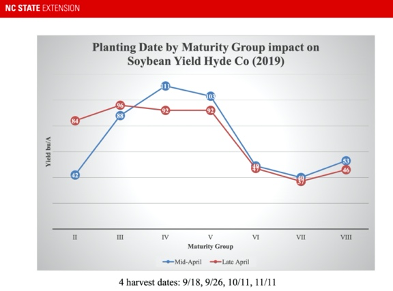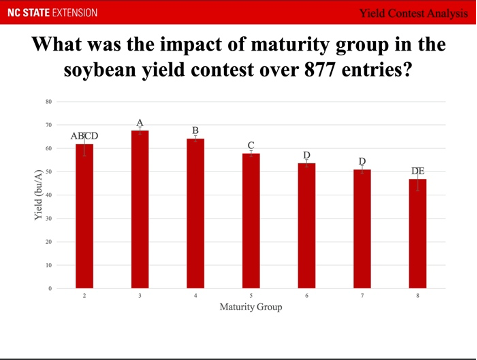The Three Most Critical Choices for High Soybean Yield
go.ncsu.edu/readext?772408
en Español / em Português
El inglés es el idioma de control de esta página. En la medida en que haya algún conflicto entre la traducción al inglés y la traducción, el inglés prevalece.
Al hacer clic en el enlace de traducción se activa un servicio de traducción gratuito para convertir la página al español. Al igual que con cualquier traducción por Internet, la conversión no es sensible al contexto y puede que no traduzca el texto en su significado original. NC State Extension no garantiza la exactitud del texto traducido. Por favor, tenga en cuenta que algunas aplicaciones y/o servicios pueden no funcionar como se espera cuando se traducen.
Português
Inglês é o idioma de controle desta página. Na medida que haja algum conflito entre o texto original em Inglês e a tradução, o Inglês prevalece.
Ao clicar no link de tradução, um serviço gratuito de tradução será ativado para converter a página para o Português. Como em qualquer tradução pela internet, a conversão não é sensivel ao contexto e pode não ocorrer a tradução para o significado orginal. O serviço de Extensão da Carolina do Norte (NC State Extension) não garante a exatidão do texto traduzido. Por favor, observe que algumas funções ou serviços podem não funcionar como esperado após a tradução.
English
English is the controlling language of this page. To the extent there is any conflict between the English text and the translation, English controls.
Clicking on the translation link activates a free translation service to convert the page to Spanish. As with any Internet translation, the conversion is not context-sensitive and may not translate the text to its original meaning. NC State Extension does not guarantee the accuracy of the translated text. Please note that some applications and/or services may not function as expected when translated.
Collapse ▲While row-spacing, plant population, type of tillage, planting date, varietal selection, fertilization practices, inoculation, use of yield-enhancing products, herbicide choices, and insect management are important to soybean production, which of these are the most critical? For years growers have sought to increase yield without knowing for sure which decision most impacts yield. Thus, yield has increased, but not as consistently within North Carolina as other states.
NC State University faculty seeking to determine an answer have reviewed decades of NC State University Official Variety Test results, on-farm trials, and entries into the NC Soybean Yield Contest. Statistical analysis shows that while some practices do indeed add yield, they are not the most critical factor that determines whether a grower realizes high yield.

Comparison of US, NC Soybean Yield Contest Entries, and NC Soybean Yield Average (Courtesy of Dr. Rachel Vann, NC State University Crop & Soil Science)
Examine the chart above showing soybean yield over the past twenty years. The state average is below the US average as well as those that enter the NC State University Soybean Yield Contest. In part, this is due to a reluctance to two things: Selecting earlier maturing soybean varieties and choosing an earlier planting date. Between these two factors, analysis of data shows that the single most important decision as to whether a grower has high yield or average yield is determined by the maturity group selected.
The chart below, Soybean Planting Dates and Maturity Group Relationship, shows that the highest yielding soybeans were those in maturity group 3-5, regardless of planting date. This trend to plant earlier maturing soybeans has been adopted

Soybean Planting Date and Maturity Group Relationship (Courtesy of Dr. Rachel Vann, NC State University Crop & Soil Science)
within most of the US soybean production areas. Later maturing varieties offer advantages but attempts to increase yield by changing production practices affords only limited benefit of yield increase.
Similarly, data analysis of all NC Soybean Yield Contest entries show that early maturing soybean varieties tend to produce higher soybean yield. In this analysis, tillage, planting dates, fertilization, and other management practices were highly varied. The most significant management choices were again emphasized to be maturity group selection and planting date.
The next most influential factor that determined higher soybean yield was use of a fungicide. However, whether use of a fungicide resulted in only a slight increase, no increase, or large increase in yield is depended upon several factors. First, larger increases in yield results from use of a fungicide with multiple modes of action. Application of a fungicide with a single mode of action frequently resulted in no, or only slight yield increases. Secondly, fungicides applied when a pathogen is present and conditions favor disease development almost always provided a yield increase compared to an untreated check. However, when fungicides were applied automatically, yield may or may not increase. In this latter situation, little to no increase in yield resulted from fungicide use if the yield potential of the crop was not above 55 bu/ac or greater. Again, this enforces data presented over the years any fungicide application yield increase is related to realistic yield potential. In other words, one may get only a small percentage increase in yield. Data across the Mid-South also confirm that fungicide yield increase for soybean are highly variable, if at all.

Comparison Yield by Maturity Group for Mid-April through Mid-July Planting( Courtesy of Dr. Rachel Vann, NC State University Crop & Soil Science)
The third most common predictor of high soybean yield was planting date. Over the years as systems of production have changed, the US is simply planting earlier than traditionally planted. Early planted soybeans are more likely to reach optimum height prior to bloom and have adequate root systems to withstand heat/drought stress. Note from the graph above that all maturity groups (X-Axis) performed better than when planted late. Strictly from a planting date viewpoint, late April through Mid-May provided the highest soybean yield.
In summary, this study shows that Maturity Groups III-V, planted from Mid-April through Mid-May provided the best indicators of successfully soybean yield. Use of a fungicide often enhanced yield but whether the yield increase was slight or significant depended upon whether a disease was present and/or potential yield environment. Equally as critical is to note that row width, foliar yield enhancements, and other management decisions were not good predictors of whether higher yield will result. This suggest that many growers should consider switching to earlier maturing varieties and/or earlier planting dates.
Whether or not switching to earlier maturing soybeans and an earlier planting date is feasible is not an easy choice. One must consider planting equipment needs to determine whether one can plant corn and soybean simultaneously. Too, selection of variety, like corn, needs to be those that either have already bloomed by mid-June to avoid this period of extreme heat and drought we typically experience during this time. However, one that will bloom shortly after this period will also work well. Another consideration is that we typically have cold, wet soils during the proposed planting period so fungicide treatments for seed or one applied in-furrow at planting are warranted. Lastly, one must be willing to harvest timely. Excessive loss of yield or quality is noted for Maturity Group 3.0-4.5. As such, we may need to desiccate fields prior to harvest. Lastly, storage or the ability to sell must be available for the early planted crop. These are simply a few of the considerations that must be studied prior to changing systems. More information can be found at the NC State Extension Soybean website.






